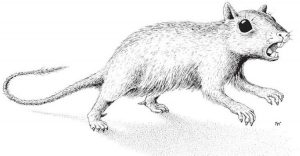
During an expedition to the Krasnoyarsk Territory, scientists from Tomsk State University and St. Petersburg State University (TSU and SPBU), discovered the remains of a previously unknown mammal, the baidabatyr.
It is classified among multituberculates, one of the ancient taxa of mammals of the Middle Jurassic. The name derives from the structure of its teeth. These animals appeared in the Jurassic period and survived the mass extinction of species at the end of the Cretaceous. Some species of multituberculates survived into the Paleogene. Thus, this clade/group has existed for about 150 million years.
“Baidabatyr is a multituberculate mammal. We found only one tooth, and immediately realized that the characteristic number and location of the tubercles indicates that this is a species previously unknown to science. This is an important find for Western Siberia,” said Stepan Ivantsov, a TSU paleontologist.
He clarified that there are no present representatives of this order—they died out about 20 million years ago.
“Judging by the structure of the tooth, it was a herbivorous animal, and probably ate seeds. The size of the tooth is a couple of millimeters, which means that the animal was the size of a hamster or slightly larger. The name was composed of the words ‘bidarka’ (kayak)—because the site of the find can be reached only by kayak—and ‘batyr,’ which means ‘hero,’ in Turkish. The first representatives of this taxon were found in Mongolia, and the name of most species traditionally includes the Mongolian word ‘baatar.’ We decided to name it in Turkish, because it is one of the local languages,” said Stepan Ivantsov.
According to the scientist, the find was made on the Bolshoy Kemchug River in the remote taiga. The southeast of Western Siberia in the Early Cretaceous was a refugium—an area where some species of the Jurassic period were preserved into the Cretaceous, several million years longer than taxonomic relatives elsewhere on Earth.
The remains of the animal were discovered in the summer of 2015. However, before the scientists officially announced their discovery, they had to describe the find and publish an article in a leading international journal.
Reference:
Alexander Averianov et al, An enigmatic multituberculate mammal from the Early Cretaceous of Siberia, Russia, Journal of Vertebrate Paleontology (2017). DOI: 10.1080/02724634.2017.1293070
Note: The above post is reprinted from materials provided by National Research Tomsk State University.










